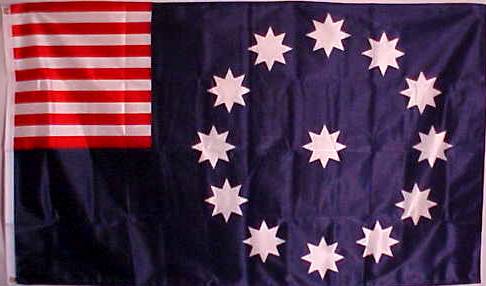 |
| Centre Square ca. 1776 |
On Monday, July 8, the Declaration of Independence was publicly read in Easton,
Pennsylvania, (as well as in Trenton, New Jersey, and Philadelphia itself). A mural by Robert C. Burns, apparently unavailable in an on-line image, hanging
in the Northampton County Courthouse depicts the reading in Easton from the steps of the old county courthouse in Centre
Square. A large crowd had gathered. The colonel and field officers of
the 1st Battalion were among the select group gathered about the entrance to
the building. Just before the reading started, a company of Light Infantry
marched down Northampton Street to the beating of drums and the playing of
fifes. The Ensign of the company carried a flag, "the
device for which is the thirteen united colonies."
 |
| The Easton Flag |
As the company of
infantry was drawn up in front of the courthouse and the new flag held at
attention, Robert Levers, a member of the Committee of Observation and
Inspection (and who had been in Philadelphia working on a new government for Pennsylvania), read the imperishable document to a
large, attentive and serious audience. At the close of the reading the bell in
the cupola pealed forth the glad tidings of the birth of the Nation and the
spectators "gave their hearty consent with three loud huzzas and cried
out "May God long preserve and unite the Free and Independent States of
America." Northampton County's liberty bell which pealed from the cupola
of the old courthouse in July, 1776, is now on display in the Government
Center.
 |
| Centre Square today |
One of the Pennsylvania representatives (John Dickinson) refused to sign the Declaration of Independence and George Taylor of Easton was appointed to replace him. He signed his name to the Declaration of Independence on August 2, 1776. His house sits at 4th and Ferry Sts.
That flag. Eastonians firmly believe that their city flag is the same as that displayed on the Glorious Eighth, although there is no chain of custody. Much like the Shroud of Turin, there is a gap in its history.
"Just who retained possession of the flag is of course only traditional. Naturally, it may be presumed it was either Colonel Robert Levers or Lieutenant Valentine Beidelman, both of whom were trusted custodians of local affairs of the new government." -- History of Northampton County
On September 6, 1814, fourteen-year old Rosanna Beidleman presented a flag to Captain Abraham Horn's Company as they left for Camp DuPont, Marcus Hook, for service in the War of 1812. This is the present Easton Flag, and it is supposed to be the same as used by the earlier Easton Light Infantry. "The probability is that the flag presented to the emergency company was
the original Revolutionary flag, on account of the presentation being
made by a descendant of the trusted lieutenant of the county." (History of Northampton County) It presents 13 eight-pointed stars in the blue field and 13 red-and-white stripes in the canton. Almost, it is the reverse of the "Betsy Ross" flag. If the flag dates only from 1812, it would likely sport 15 stars and 15 stripes as other flags of that time did.
At the conclusion of the war, the Company disbanded and returned home with the flag. Members of Captain Horn's Company, along with Captain Peter Nungesser's Company of Light Infantry, formed the Easton Union Guards in 1816. In 1821 they deposited the flag with the Easton Library Company for safe keeping in Library Hall on North Second Street.
At the time of the Sesquicentennial held in Philadelphia in 1926, the flag was removed from its pole, placed between two pieces of plate glass and framed for exhibition. On its return, it was bolted to the east wall of the Easton Public Library's marble stairway in the front entrance to the Carnegie building. After some repairs over the years, it remains on exhibit in the Library.
References



No comments:
Post a Comment